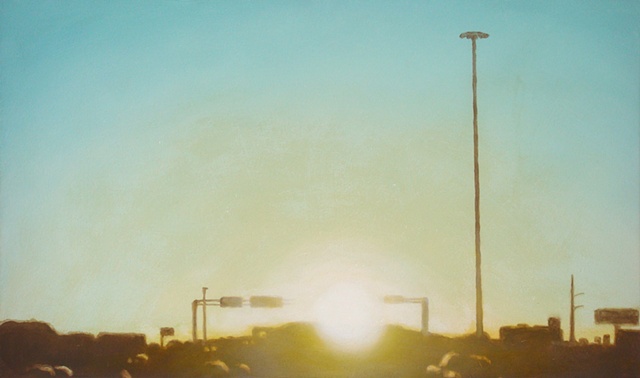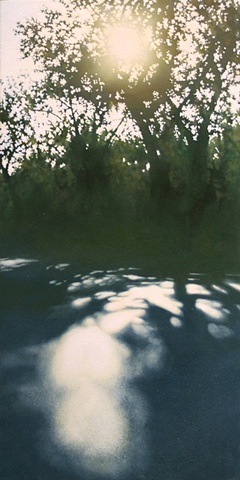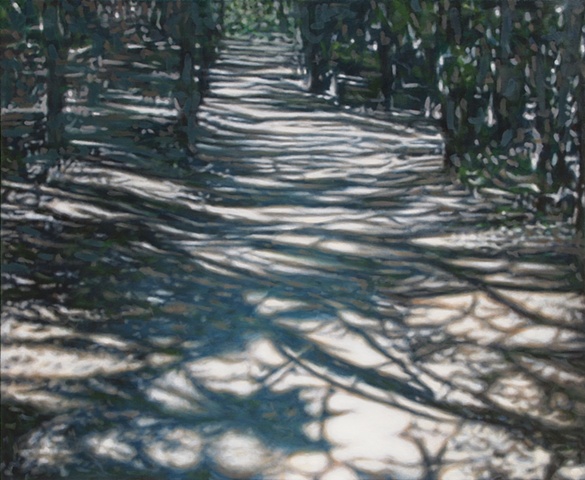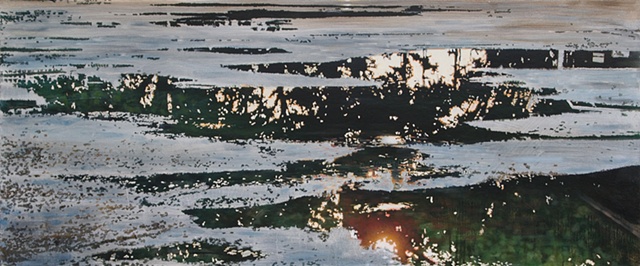A Light Provoking: A Response to the Paintings of David Anthony Harman
In 1905 Albert Einstein published papers on light and special relativity that disagreed with much of the scientific consensus and clarified much of the rest. No, he wrote, light is not just a wave. Look! Look how it acts like a particle. Look here: watch it bend around the edges of large objects—such as the earth. You should not see but half the sun, in these first moments of its setting—but see there it dips below the horizon. The light bends around the curvature of the earth to give you that final, full glow. That is what he said. (Those are not his exact words, but they are accurate enough to serve our purposes.) Only after ten years did the scientific community (hesitantly) begin to see all of what he saw. (This is only one of a number of discoveries from these seminal papers.) And as far as I can tell, our intuitions, our general and implicit understandings of light, are still having trouble taking Einstein’s insights to heart.

January, Okay
The paintings of David Anthony Harman often work contrary to our intuition of light. He captures the abstruse edges of shadows and that odd phenomenon in which light from the sun—and this is the point at which we often avert our eyes—bends over the horizon or around the branches of trees, forming a more complete sphere of light than we should (according to our intuition) be able to see. Einstein, in 1905, helped us understand why light does this. We witness the phenomenon (without the difficulty of looking at the sun) in the breached horizon of Harman’s January, Okay.
In Old Mill light acts similarly: while those things most common to our regular line of vision—the brush and trees across the middle of the painting—are shaded out, the sunlight itself asserts its presence and the dapple on the foreground becomes unordinarily vivid—worthy of investigation. How does light do that? Can it actually be interacting with the trees to create this? Surely it interacts with the trees; it bends around the branches, weaves through the branches, to create the half light, the precise imprecision, the variations of shade that act with a bit of the cohesion, that stickiness, of water.

Old Mill
Thus these paintings are not studies of light alone because light has that odd quality of not being able to be studied alone. Light, in its interaction, illumines place and time. You Came, We Went is a poignant example; it is haunted by the memory referred to by the title. Harman captures the interaction between place, viewer, and the light of the moment.
The patterns of light captured in Old Mill or You Came, We Went will change with the wind; a painting like Still, Still gives us a moment that lingers, and does so while reorienting. Re- rather than dis-orient: the composition itself has the balance of any of a number of other pieces with the sun low on the canvas, almost setting behind the puddle’s gravel lip. Thus it has that sense of proper orientation contrasting with its identity as a flipped reflection.
And when I return to this painting, being drawn to the reflection, I fight against the flatness of the gravel to seek depth in the shallow pools. Perhaps I’ll forget for a moment that it is a reflection since the original sunset is not present to the viewer (how the gravel can remain there so subtly), or I’ll focus in around the sun and forget that I have been reoriented by a flipped image. There again, the sense of proper orientation mixes with the reorientation.

You Came, We Went
I could further describe this image with the notion of paradox or a discussion of Dante’s fascination with mirrors as a key to the anagogical. And I don’t think that would be necessarily misguided; nonetheless I think it more proper to identify Harman’s art as what Adam Kirsch would call a “poetry of the earth” (poetry, of course, extending to all arts, as one of his defining examples is a painting). This emphasizes the artist’s role of “witness” (compared to twentieth century artists’ role of world-creating) in which he has “a strong sense of ethical obligation . . . as bearer of memories and perceptions” and as one “seeing nature so intently that it seems to yield up secrets.” Art of the earth is deeply rooted in this primary role. Kirsch cites Heaney for his second point: capturing the sensual world has “spiritual significance.” Certainly no one picking up Dappled Things would disagree, but I’m trying to point to exactly how the sensual opens up into the spiritual significance in Harman’s work, because it does not do so in the medieval mode of Dante, based in biblical exegesis, or in the Romantic mode of Beethoven; nor like Picasso, Yeats, or Mondrian; not even in the sacramental mode of Miss O’Connor’s grotesque writing. I’m trying to discover exactly how Harman’s work provokes the world to yield up (as it seems) its secrets.
Elm Street, the cover piece, certainly cannot go unmentioned here. How often we look away from a scene like this. The light source originates slightly left of center. The light is pulled right by the limbs of the tree, is drawn down the less direct path of the street to the viewer. It is drawn to the objects it can illuminate. (Let us not take this observation too tropologically, not yet.) We are witnessing diffusion in the trees (a pre-Einstinian discovery), a well-observed reflection in the street, and the photobleach effect of a bright, clear city day. Though I wonder if the buildings in the foreground would benefit from more depth, and though I wonder how much of the natural diffusion mixes with any presence of a lens, there is an undeniable mastery in the mix of light and dimension.

Still, Still
When Kirsch qualifies his phrase—“seeing nature so intently that it seems to yield up its secrets”—he qualifies it, in large part, because nature isn’t keeping any secrets. It merely seems so when we look and find something heretofore hidden from our sight. And this is the vision for which I compared Harman to Einstein. Again, I think only after we have been shaken of our mundane disposition (especially now with virtual realities and scientism’s skepticisms obscuring our simple ability to see), can we legitimately look for the spiritual significance. Part of poetry, according to T.S. Eliot, is its ability to shock words back into their meaning. Eliot, like Kirsch after him, spoke of poetry implying all art. Part of Harman’s work is displacing an image—a landscape or cityscape—back to its meaning—in which a landscape or cityscape is not merely that. From his paintings we get this peculiar sense about the place pictured—like getting to peep briefly and sidelong into what it really is, which is more than just a landscape or cityscape.
Not only, then, does his work give us a renewed sense of the ordinary, not only does he allow us to see “nature so intently that it seems to yield up secrets,” it also momentarily shake us out of our set disposition, our everyday vision into—and here is where we can look for spiritual resonance—into the tension between the ordinary and the extraordinary. Yes, we now see anew to an extent. Furthermore, after time spent with these paintings, I dare say we cannot understand Christ’s words, I am the Light, in the same way; I dare say we are better equipped to address nature’s relation to the supernatural, to our faith. Harman’s paintings provoke the world to speak of this relation.
Resources
Kirsch, Adam. The Taste of Silence. Poetry, Jan 2008. http://www.poetryfoundation.org/poetrymagazine/article/180561
